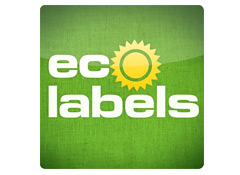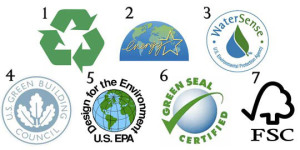Eco-labels. Seen ’em? Counted on ’em?

A. Definition
Eco-labels are affixed to products that pass eco-friendly criteria laid down by government, association or standards certification bodies. The criteria utilise extensive research based on the product’s life cycle impact on the environment. (source: Google search)
Here are some we all probably know–
- Energy Star (2) is an eco-label found on many household appliances and represents that U.S. Government energy efficiency standards have been met in product testing.
- Design for the Environment (5), or DfE, is another U. S. Government testing service. Just so that you know it’s real:
- “When you see the DfE logo on a product it means that the DfE scientific review team has screened each ingredient for potential human health and environmental effects and that—based on currently available information, EPA predictive models, and expert judgment—the product contains only those ingredients that pose the least concern among chemicals in their class.” (quoted from the website)
- FSC (7) stands for Forestry Stewardship Council, an organization which certifies tree harvesting conducted in sustainable fashion. Home Depot sells FSC-certified lumber.
- All the toilet fixtures in my home are certified WaterSense (3), denoting high-efficiency design and operations, saving save thousands of gallons of water annually/ea., and money (think: water bill and electric, if well water).
- Green Seal Certified (6) may be one you’ve noticed on household cleaners. It and DfE are trustworthy of good science for rooting out chemicals harmful to the environment and users both.
 Another 3rd-party rater I use frequently as a reference for green cleaning products, even if certified by DfE or Green Seal, is the Environmental Working Group. It’s a non-profit supported by major foundations such as The Walton Family Foundation. It rigorously studies the chemicals used in common household and other products, identifying those which are toxic, or potentially toxic to the human body. Funders, also including corporations and individuals, enable lobbying by EWG to have harmful chemicals in products replaced by eco-friendly chemicals. It’s even got a webpage titled: “Five Things FDA and EPA Didn’t Tell You About Seafood Safety.” I trust the work these folks do in informing/protecting us from bad products.
Another 3rd-party rater I use frequently as a reference for green cleaning products, even if certified by DfE or Green Seal, is the Environmental Working Group. It’s a non-profit supported by major foundations such as The Walton Family Foundation. It rigorously studies the chemicals used in common household and other products, identifying those which are toxic, or potentially toxic to the human body. Funders, also including corporations and individuals, enable lobbying by EWG to have harmful chemicals in products replaced by eco-friendly chemicals. It’s even got a webpage titled: “Five Things FDA and EPA Didn’t Tell You About Seafood Safety.” I trust the work these folks do in informing/protecting us from bad products.
 I’ve never noticed image #4 above since becoming a member o the U.S. Green Building Council in 2010. It doesn’t include the LEED sash, but may be a very early version of today’s symbol shown at the left. But, I think it can be thought of as a kind of eco-label. It represents my professional work and my firm’s membership in the USGBC. It has established a number of voluntary 3rd-party building rating systems that go a long way towards ensuring higher energy efficiency and healthy interiors in the design, construction, operations and maintenance of commercial, institutional and residential buildings. USGBC rating systems for new construction include: office; healthcare; schools; retail; hospitality; data centers; and, warehouse & distribution centers. These new building rating systems are typically administered by the likes of me and my firm as I have earned the coveted LEED AP BD+C accreditation and am a successful practitioner.
I’ve never noticed image #4 above since becoming a member o the U.S. Green Building Council in 2010. It doesn’t include the LEED sash, but may be a very early version of today’s symbol shown at the left. But, I think it can be thought of as a kind of eco-label. It represents my professional work and my firm’s membership in the USGBC. It has established a number of voluntary 3rd-party building rating systems that go a long way towards ensuring higher energy efficiency and healthy interiors in the design, construction, operations and maintenance of commercial, institutional and residential buildings. USGBC rating systems for new construction include: office; healthcare; schools; retail; hospitality; data centers; and, warehouse & distribution centers. These new building rating systems are typically administered by the likes of me and my firm as I have earned the coveted LEED AP BD+C accreditation and am a successful practitioner.
 Then there are other eco-labels that may not mean a lot. Ha, ha! For that there’s an app. Broke down and paid $.99 the other day for the iPhone app called EcoLabels. It’s a Consumer Reports product that helps consumers know whether the claims of products we commonly use or may be considering for purchase are truthful. Want to know if 100% Vegan means anything? Or, non-toxic? (No, neither does.) But, California Certified Organic Farmers does; Certified Biodegradable and Animal Welfare Approved too. I suspect there are many among you also willing to dish $.99 for a decent handle on the healthiness of products for sale in supermarkets and elsewhere.
Then there are other eco-labels that may not mean a lot. Ha, ha! For that there’s an app. Broke down and paid $.99 the other day for the iPhone app called EcoLabels. It’s a Consumer Reports product that helps consumers know whether the claims of products we commonly use or may be considering for purchase are truthful. Want to know if 100% Vegan means anything? Or, non-toxic? (No, neither does.) But, California Certified Organic Farmers does; Certified Biodegradable and Animal Welfare Approved too. I suspect there are many among you also willing to dish $.99 for a decent handle on the healthiness of products for sale in supermarkets and elsewhere.
Incidentally, I blogged on sustainable seafood being claimed in Sam’s and other major grocers, and why, back in May 2013. The piece notes several organizations working to insure proper harvesting and wholesale delivery methods. In an August 2013 post in the In Sundry Department (scroll down) I mentioned the Monterey Bay Aquarium “Seafood Watch” and its Super Green List. A free app is offered there for help in choosing sustainable seafood from restaurant menus and retail grocers.
